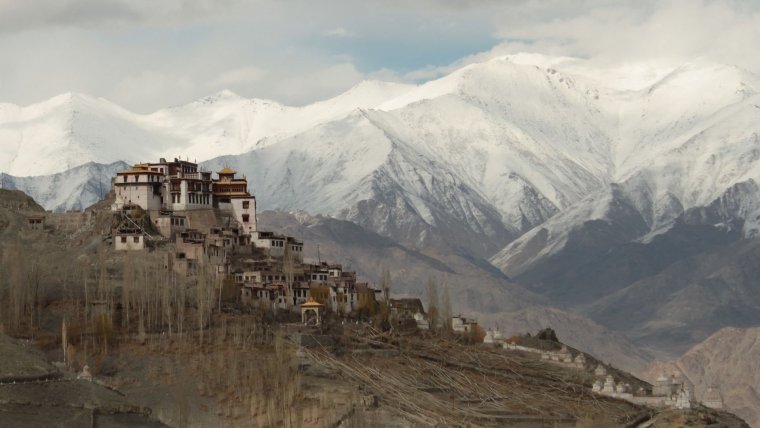| Published in Attractions / Temples, Ashrams, Monasteries |
Matho Monastery, Ladakh, India
Sakya Tradition, 15th century.
Matho Monastery, or Matho Gonpa or Mangtro Monastery or Mangtro Gonpa, from the Tibetan "mang" that means "many" and "tro" that means "happiness", is a Tibetan Buddhist monastery located 26 kilometers southeast of Leh in Ladakh, northern India, on the banks of the Indus River, across Thiksay Monastery.
History
Matho Monastery was founded in 1410 by Lama Dugpa Dorje, it belongs to the Sakya Order. It is noted for its six-hundred-year-old thangkas and its Matho Nagrang Festival.

Matho Gonpa, the only representative of the Sakya sect of Tibetan Buddhism in Ladakh. Photo: Nellyrieuf, Wikipedia
Features
Most of the buildings are, apparently, rather dilapidated but there is a new assembly hall or dukhang which was built in 2005 and which has very colorful paintings and a Śākyamuni Buddha as main statue.
There is a small chapel on the top level containing images of Sakya Pandita1 and other Sakya lamas.
There is a museum adjoining it with several very beautiful thangkas, dating back to the 14th century, some of which are thought to have been brought from Tibet. Unfortunately, many of them are very worn.
The masks and robes used by the lamas in the annual dance festival may also be seen in the museum.
Festivals
Because Matho is not on the main highway from Leh, it sees fewer visitors than Hemis, Thiksay or Shey. However, it is known to outsiders for its annual Oracle Matho Nagrang (Festival of the Black Oracles), held on the 14th and 15th days of the first month of the Tibetan calendar.
During this festival, two oracles, known as "Rongtsan", are said to inhabit for a few hours the body of two monks. The purpose of these oracles is to attempt to predict the fortunes of the local village communities for the coming year.
Two monks that are to be the oracles’ vehicles are chosen every three years by the monks of the monastery. The first year the monks will have to meditate for 9 months before the festival, and the following two years the meditation will last 2 months.
When possessed, they are said to be able to perform many astounding feats such as cutting themselves with knives and walking around the ramparts of the top storey blindfolded with no fear of falling down the precipice below.
While in this trance state they answer questions about the prospects for Matho and Ladakh for the coming year as well as personal questions put to them by individuals. However, if skeptical questions are put to the oracle to test him, he is said to react "with a frenzied display of anger."

Matho Monastery Festival of the Black Oracles. Photo: Tsewang Tamchos
Travel and Visiting
The monastery is 26 km away from Leh and can be reached by taxi or local buses from Leh. Flights from Delhi and Jammu to Leh are available. The months from November to February experience heavy snowfall and all the roads connecting Leh remains closed.
The monastery is open each day of the week and no entry fee is required. About two hours are required to visit monastery and its attractions.
Sources
• https://en.wikipedia.org/wiki/Matho_Monastery
• https://www.youtube.com/watch?v=sr89ANow4F4&ab_channel=IndiaInMotion
• https://www.travelogyindia.com/leh-ladakh/matho-gompa.html
Footnotes
1. Sakya Pandita Kunga Gyeltsen (1182 – 1251) was a Tibetan spiritual leader and Buddhist scholar and the fourth of the Five Sakya Forefathers.
Künga Gyeltsen is generally known simply as Sakya Pandita, a title given to him in recognition of his scholarly achievements and knowledge of Sanskrit. He is held in the tradition to have been an emanation of Mañjuśrī, the embodiment of the wisdom of all the Buddhas.
Sakya Pandita was also known as a great scholar in Tibet, India, Mongolia and China and was proficient in the five great sciences of Buddhist philosophy, medicine, grammar, dialectics and sacred Sanskrit literature as well as the minor sciences of rhetoric, synonymies, poetry, dancing and astrology.
He is considered to be the fourth Sakya Forefather and sixth Sakya Trizin and one of the most important figures in the Sakya lineage.
YOU MAY ALSO LIKE






 If you own or manage a travel-related business such as a hotel, a bed-and-breakfast, a restaurant, a pub or a cafeteria, you can create a web page for your business for free on Titi Tudorancea Travel Info. » |